Intermittent Beginning to the Formation of Hydrogenous Ferromanganese Nodules in the Vast Field: Insights from Multi-Element Chemostratigraphy Using Microfocus X-ray Fluorescence
Abstract
:1. Introduction
2. Materials and Methods
2.1. General Description of the Sampling Sites
2.1.1. East and Southeast EEZ Regions
2.1.2. Around Takuyo Daigo Seamount Region
2.2. Microfocus X-ray Fluorescence (µ-XRF) Mapping
3. Results
3.1. East and Southeast EEZ Regions
3.2. Around Takuyo Daigo Seamount Region
4. Discussion
5. Conclusions
Supplementary Materials
Author Contributions
Funding
Data Availability Statement
Acknowledgments
Conflicts of Interest
References
- Hein, J.R.; Petersen, S. The geology of manganese nodules. In Deep Sea Minerals: Manganese Nodules: A Physical, Biological, Environmental and Technical Review; Baler, E., Beaudoin, Y., Eds.; Secretariat of the Pacific Community: Noumea, New Caledonia, 2013; Volume 1B, pp. 7–18. [Google Scholar]
- Hein, J.R.; Koschinsky, A.; Kuhn, T. Deep-ocean polymetallic nodules as a resource for critical materials. Nat. Rev. Earth Environ. 2020, 1, 158–169. [Google Scholar] [CrossRef]
- Glasby, G.P.; Stoffers, P.; Sioulas, A.; Thijssen, T.; Friedrich, G. Manganese nodule formation in the Pacific Ocean: A general theory. Geo-Marine. Lett. 1982, 2, 47–58. [Google Scholar] [CrossRef]
- Nishimura, A. Sedimentation and hiatuses in the Central Pacific basin: Their relationship to manganese nodule formation. In Geology and Offshore Mineral Resources of the Central Pacific Basin; Keating, B.H., Bolyon, B.R., Eds.; Circum-Pacific Council for Energy and Mineral Resources, Earth Sciences Series; Springer: Berlin/Heidelberg, Germany, 1992; Volume 14, pp. 179–203. [Google Scholar]
- Machida, S.; Sato, T.; Yasukawa, K.; Nakamura, K.; Iijima, K.; Nozaki, T.; Kato, Y. Visualisation method for the broad distribution of seafloor ferromanganese deposits. Mar. Georesour. Geotechnol. 2021, 39, 267–279 (published on line in 2019). [Google Scholar] [CrossRef] [Green Version]
- Sorem, R.K.; Reinhart, W.R.; Fewkes, R.H.; McFarland, W.D. Occurrence and character of manganese nodules in DOMES Sites A, B, and C, east equatorial Pacific Ocean. In Marine Geology and Oceanography of the Pacific Manganese Nodule Province; Bischoff, J.L., Piper, D.Z., Eds.; Plenum Publishing Corp.: New York, NY, USA, 1979; pp. 475–527. [Google Scholar]
- Heath, G.R. Burial rates, growth rates, and size distributions of deep- sea manganese nodules. Science 1979, 205, 903–904. [Google Scholar] [CrossRef] [PubMed]
- Usui, A. Regional variation of manganese nodules facies on the Wake-Tahiti transect: Morphological, chemical and mineralogical study. Mar. Geol. 1983, 54, 27–51. [Google Scholar] [CrossRef]
- Bolton, B.R.; Bogi, J.; Cronan, D.S. Geochemistry and Mineralogy of ferromanganese nodules from the Kiribati region of the Eastern Central Pacific. In Geology and Offshore Mineral Resources of the Central Pacific Basin; Keating, B.H., Bolyon, B.R., Eds.; Circum-Pacific Council for Energy and Mineral Resources, Earth Sciences Series; Springer: Berlin/Heidelberg, Germany, 1992; Volume 14, pp. 247–260. [Google Scholar]
- Kuhn, T.; Wegorzewski, A.; Rühlemann, C.; Vink, A. Composition, Formation, and Occurrence of Polymetallic Nodules. In Deep-Sea Mining; Sharma, R., Ed.; Springer: Berlin/Heidelberg, Germany, 2017; pp. 23–63. [Google Scholar]
- Hein, J.R.; Conrad, T.A.; Dunham, R.E. Seamount characteristics and mine-site model applied to exploration and mining-lease-block selection for cobalt-rich ferromanganese crusts. Mar. Georesour. Geotechnol. 2009, 27, 160–176. [Google Scholar] [CrossRef]
- Hein, J.R.; Mizell, K.; Koschinsky, A.; Conrad, T.A. Deep-ocean mineral deposits as a source of critical metals for High and green-technology applications: Comparison with land-based resources. Ore Geol. Rev. 2013, 51, 1–14. [Google Scholar] [CrossRef]
- Machida, S.; Nakamura, K.; Kogiso, T.; Shimomura, R.; Horinouchi, K.; Okino, K.; Kato, Y. Fine-scale chemostratigraphy of cross-sectioned hydrogenous ferromanganese nodules from the western North Pacific. Isl. Arc 2021, 30, e12395. [Google Scholar] [CrossRef]
- Machida, S.; Fujinaga, K.; Ishii, T.; Nakamura, K.; Hirano, N.; Kato, Y. Geology and geochemistry of ferromanganese nodules in the Japanese Exclusive Economic Zone around Minamitorishima Island. Geochem. J. 2016, 50, 539–555. [Google Scholar] [CrossRef] [Green Version]
- Kim, J.; Hyeong, K.; Yoo, C.M.; Moon, J.W.; Kim, K.H.; Ko, Y.T.; Lee, I. Textural and geochemical characteristics of Fe-Mn crusts from four seamounts near the Marshall Islands, western Pacific. Geosci. J. 2005, 9, 331–338. [Google Scholar] [CrossRef]
- Kim, J.; Hyeong, K.; Jung, H.-S.; Moon, J.-W.; Kim, K.-H.; Lee, I. Southward shift of the Intertropical Convergence Zone in the western Pacific during the late Tertiary: Evidence from ferromanganese crusts on seamounts west of the Marshall Islands. Paleoceanography 2006, 21, PA4218. [Google Scholar] [CrossRef]
- Pan, J.; De Carlo, E.H.; Yang, Y.; Liu, S.; You, G. Effect of phosphatization on element concentration of cobalt-rich ferromanganese crusts. Acta Geol. Sin. 2005, 79, 349–355. [Google Scholar]
- Nozaki, T.; Tokumaru, A.; Takaya, Y.; Kato, Y.; Suzuki, K.; Urabe, T. Major and trace element compositions and resource potential of ferromanganese crust at Takuyo Daigo Seamount, northwestern Pacific Ocean. Geochem. J. 2016, 50, 527–537. [Google Scholar] [CrossRef] [Green Version]
- Azami, K.; Hirano, N.; Machida, S.; Yasukawa, K.; Kato, Y. Rare earth elements and yttrium (REY) variability with water depth in hydrogenetic ferromanganese crusts. Chem. Geol. 2018, 493, 224–233. [Google Scholar] [CrossRef]
- Kawabe, M.; Fujio, S.; Yanagimoto, D. Deep-water circulation at low latitudes in the western North Pacific. Deep-Sea Res. I Oceanogr. Res. Pap. 2003, 50, 631–656. [Google Scholar] [CrossRef]
- Kawabe, M.; Fujio, S.; Yanagimoto, D.; Tanaka, K. Water masses and currents of deep circulation southwest of the Shatsky Rise in the western North Pacific. Deep-Sea Res. I Oceanogr. Res. Pap. 2009, 56, 1675–1687. [Google Scholar] [CrossRef]
- Kawabe, M.; Fujio, S. Pacific Ocean circulation based on observation. J. Oceanogr. 2010, 66, 389–403. [Google Scholar] [CrossRef]
- Nakamura, K.; Terauchi, D.; Shimomura, R.; Machida, S.; Yasukawa, K.; Fujinaga, K.; Kato, Y. Three-dimensional structural analysis of ferromanganese nodules from the western North Pacific Ocean using X-ray Computed Tomography. Minerals 2021, 11, 1100. [Google Scholar] [CrossRef]
- Nakamura, K.; Machida, S.; Okino, K.; Masaki, Y.; Iijima, K.; Suzuki, K.; Kato, Y. Acoustic characterization of pelagic sediments using sub-bottom profiler data: Implications for the distribution of REY-rich mud in the Minamitorishima EEZ, western Pacific. Geochem. J. 2016, 50, 605–619. [Google Scholar] [CrossRef] [Green Version]
- Hirano, N.; Machida, S.; Sumino, H.; Shimizu, K.; Tamura, A.; Morishita, T.; Iwano, H.; Sakata, S.; Ishii, T.; Arai, S.; et al. Petit-spot volcanoes on the oldest portion of the Pacific plate. Deep-Sea Res. I Oceanogr. Res. Pap. 2019, 154, 103142. [Google Scholar] [CrossRef]
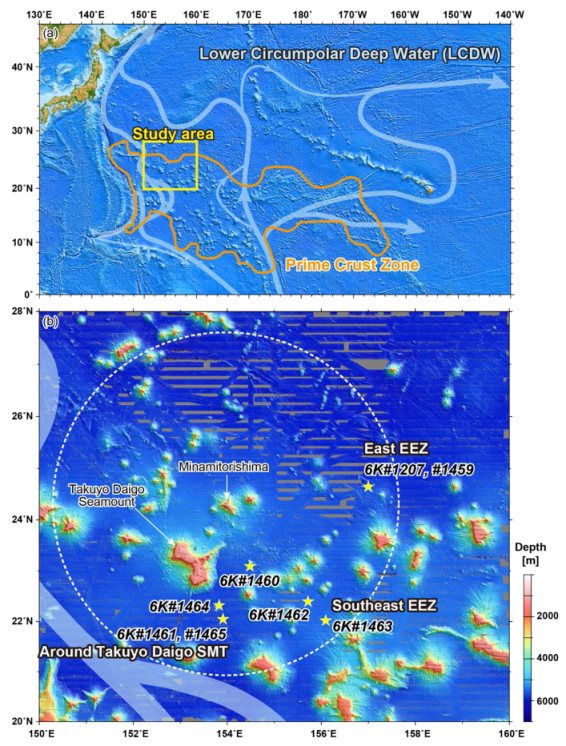
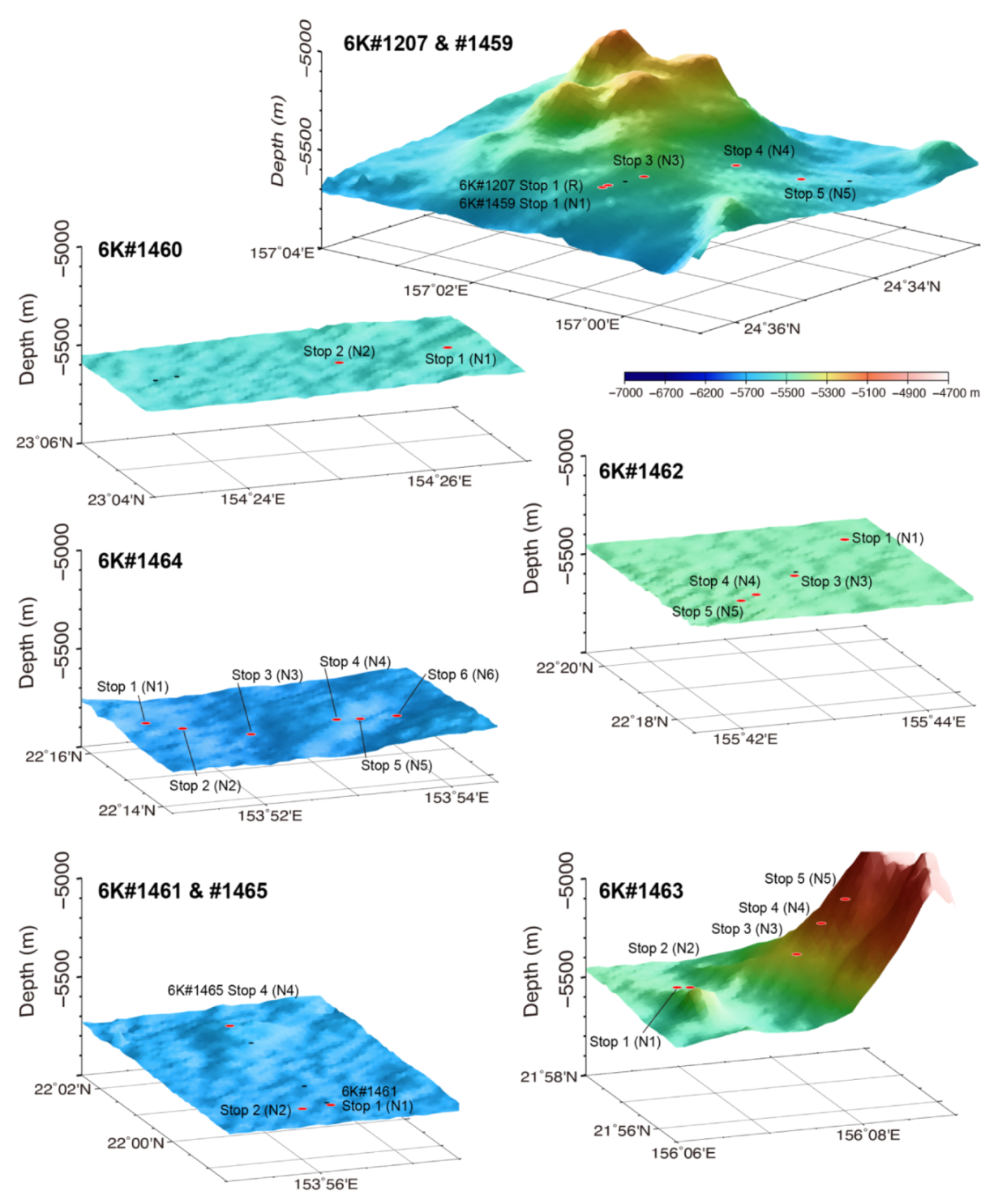
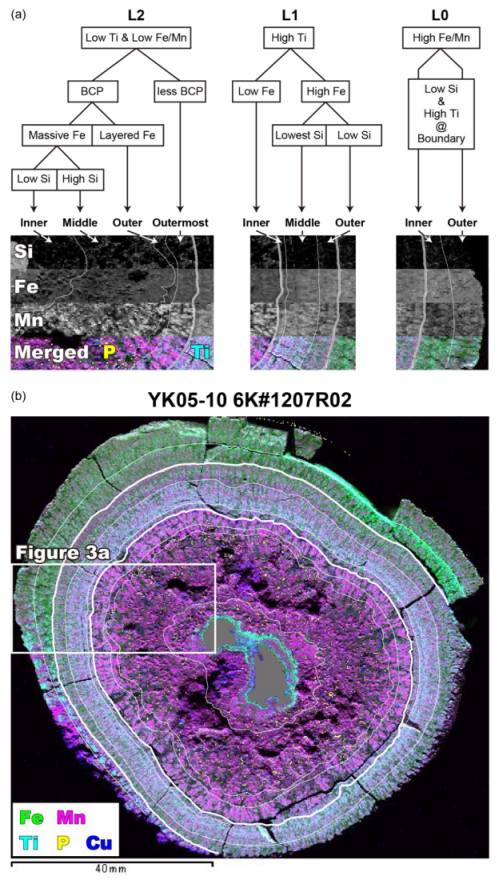
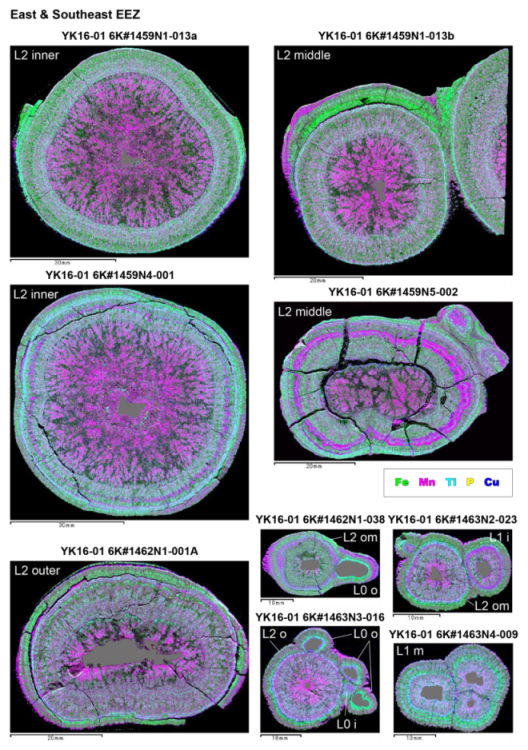
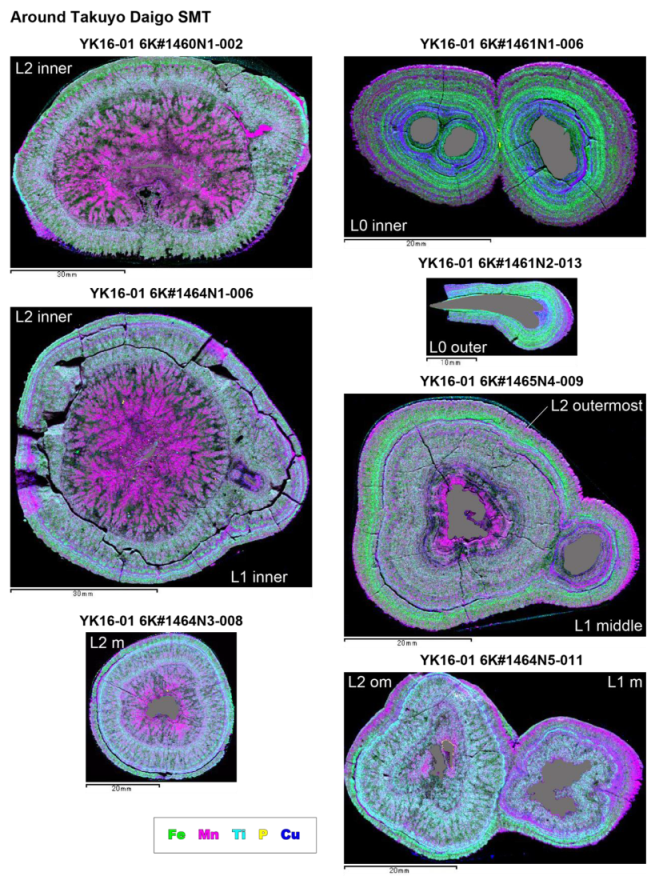
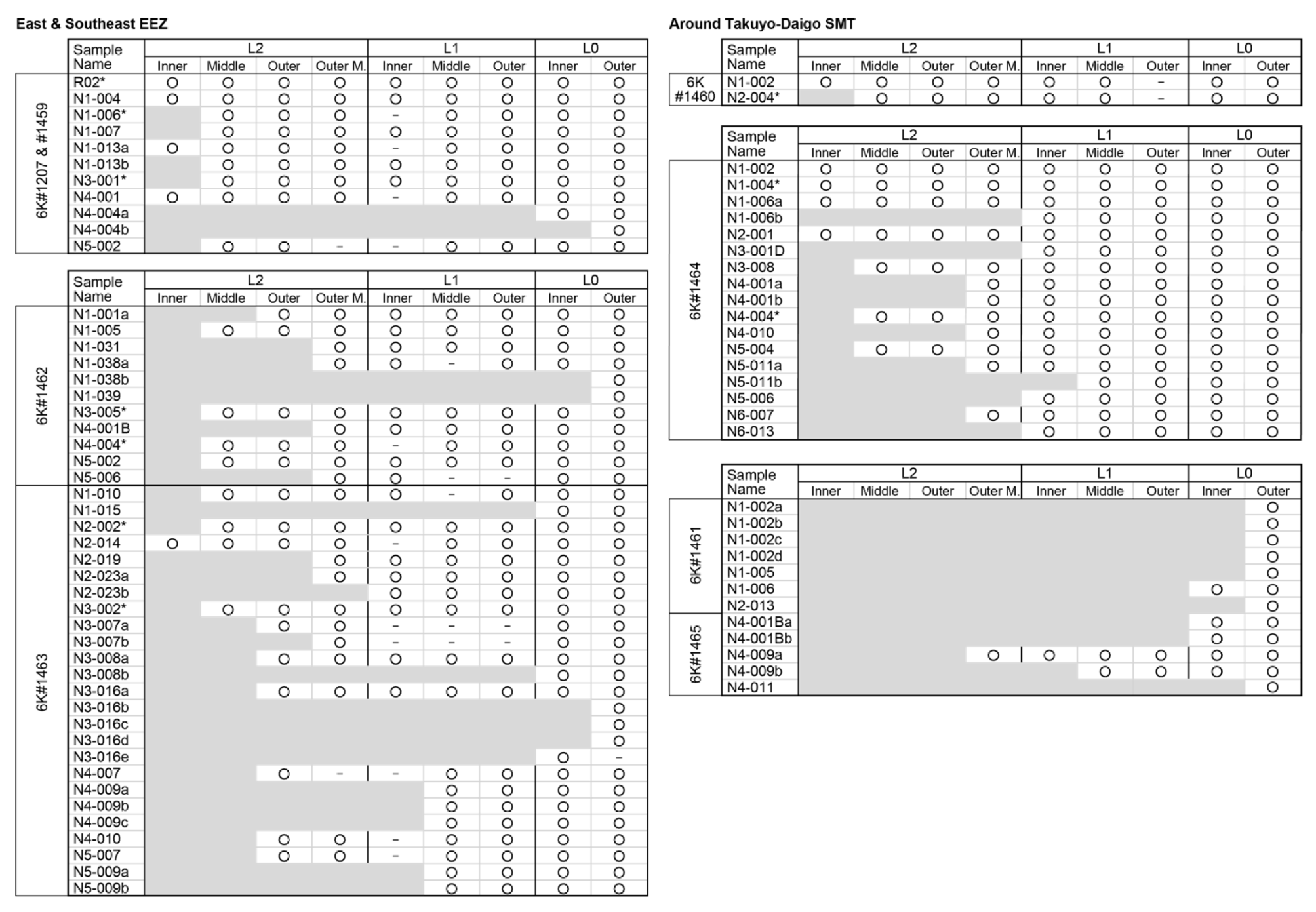
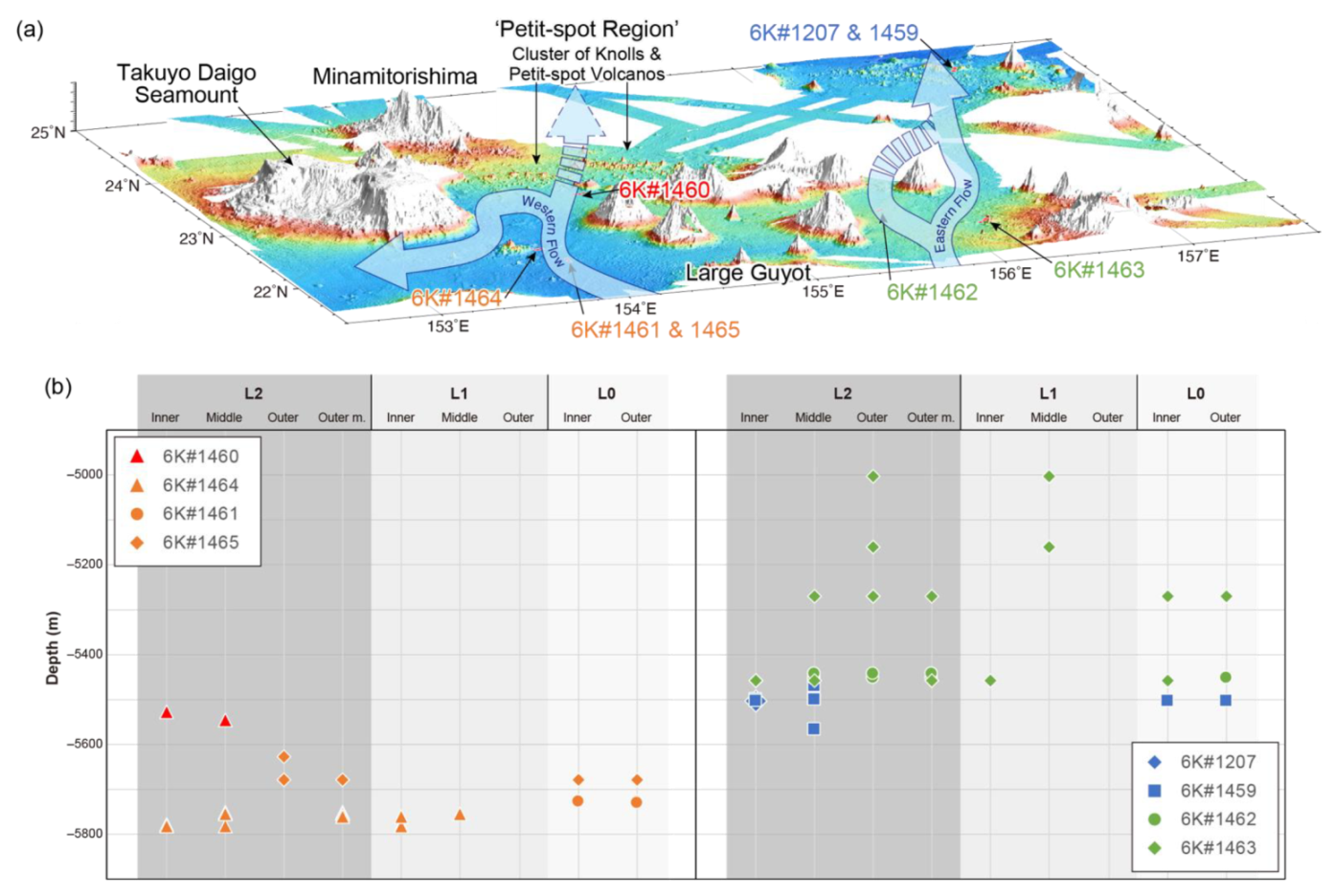
| Dive Number | Sample Name | Location | Sample Size | Analysis Parameters | |||||||
|---|---|---|---|---|---|---|---|---|---|---|---|
| Latitude (N) | Longitude (E) | Depth (m) | Max. (mm) | Med. (mm) | Min. (mm) | X (mm) | Y (mm) | Pixel Size (μm) | Total Analysis Time (ms/pixel) | ||
| 6K#1459 | 6K#1459N1-004 | 24°35.69′ | 157°00.96′ | −5501 | 72 | 71 | 66 | 71.680 | 71.680 | 140 | 76 |
| 6K#1459N1-007 | 71 | 67 | 65 | 72.704 | 66.456 | 142 | 83 | ||||
| 6K#1459N1-013a | 95 | 65 | 59 | 67.584 | 59.983 | 132 | 86 | ||||
| 6K#1459N1-013b | 53.248 | 51.168 | 104 | 79 | |||||||
| 6K#1459N4-001 | 24°34.36′ | 157°00.49′ | −5503 | 64 | 61 | 60 | 62.464 | 61.488 | 122 | 78 | |
| 6K#1459N4-004a | 34 | 26 | 14 | 23.552 | 13.392 | 92 | 162 | ||||
| 6K#1459N4-004b | 31.232 | 16.117 | 122 | 178 | |||||||
| 6K#1459N5-002 | 24°33.99′ | 156°59.97′ | −5567 | 63 | 42 | 40 | 58.368 | 38.874 | 114 | 172 | |
| 6K#1460 | 6K#1460N1-002 | 23°05.01′ | 154°26.55′ | −5527 | 80 | 71 | 57 | 78.848 | 55.286 | 154 | 163 |
| 6K#1461 | 6K#1461N1-002 | 21°59.04′ | 153°56.33′ | −5728 | 38 | 27 | 18 | 38.400 | 26.700 | 150 | 658 |
| 6K#1461N1-005 | 34 | 30 | 15 | 34.816 | 14.348 | 136 | 446 | ||||
| 6K#1461N1-006 | 40 | 22 | 19 | 40.960 | 24.560 | 80 | 191 | ||||
| 6K#1461N2-013 | 21°59.00′ | 153°56.01′ | −5729 | 32 | 20 | 14 | 29.696 | 15.312 | 116 | 592 | |
| 6K#1462 | 6K#1462N1-001A | 22°19.92′ | 155°44.06′ | −5453 | 50 | 40 | 37 | 51.712 | 37.168 | 101 | 159 |
| 6K#1462N1-005 | 60 | 47 | 44 | 60.416 | 44.014 | 118 | 84 | ||||
| 6K#1462N1-031 | 36 | 32 | 30 | 35.840 | 29.680 | 140 | 101 | ||||
| 6K#1462N1-038 | 35 | 25 | 20 | 35.840 | 20.440 | 140 | 94 | ||||
| 6K#1462N1-039 | 27 | 26 | 13 | 28.672 | 13.328 | 112 | 985 | ||||
| 6K#1462N4-001B | 22°18.34′ | 155°42.49′ | −5444 | 37 | 27 | 25 | 36.864 | 26.064 | 144 | 108 | |
| 6K#1462N5-002 | 22°18.17′ | 155°42.26′ | −5443 | 89 | 69 | 48 | 87.040 | 72.760 | 170 | 91 | |
| 6K#1462N5-006 | 31 | 24 | 20 | 31.744 | 22.506 | 124 | 647 | ||||
| 6K#1463 | 6K#1463N1-010 | 21°57.15′ | 156°06.65′ | −5458 | 50 | 50 | 47 | 52.224 | 49.572 | 102 | 80 |
| 6K#1463N1-015 | 28 | 20 | 19 | 26.112 | 18.972 | 102 | 105 | ||||
| 6K#1463N2-014 | 21°57.10′ | 156°06.77′ | −5457 | 52 | 51 | 50 | 51.200 | 51.200 | 100 | 114 | |
| 6K#1463N2-019 | 26 | 24 | 24 | 27.648 | 24.084 | 108 | 105 | ||||
| 6K#1463N2-023 | 23 | 17 | 17 | 25.088 | 17.444 | 98 | 110 | ||||
| 6K#1463N3-007 | 21°56.85′ | 156°07.82′ | −5271 | 45 | 40 | 38 | 45.568 | 38.448 | 178 | 543 | |
| 6K#1463N3-008 | 45 | 33 | 32 | 46.080 | 33.750 | 90 | 156 | ||||
| 6K#1463N3-016 | 29 | 26 | 22 | 29.184 | 26.106 | 114 | 102 | ||||
| 6K#1463N4-007 | 21°56.81′ | 156°08.07′ | −5161 | 25 | 22 | 21 | 23.040 | 20.970 | 90 | 503 | |
| 6K#1463N4-009 | 27 | 22 | 20 | 28.160 | 21.120 | 110 | 407 | ||||
| 6K#1463N4-010 | 24 | 23 | 22 | 23.040 | 23.040 | 90 | 458 | ||||
| 6K#1463N5-007 | 21°56.74′ | 156°08.30′ | −5004 | 21 | 20 | 19 | 20.992 | 19.188 | 82 | 92 | |
| 6K#1463N5-009 | 25 | 19 | 19 | 25.600 | 19.500 | 100 | 120 | ||||
| 6K#1464 | 6K#1464N1-002 | 22°15.45′ | 153°51.38′ | −5778 | 72 | 64 | 63 | 70.656 | 64.032 | 138 | 84 |
| 6K#1464N1-006 | 62 | 53 | 52 | 61.440 | 57.000 | 120 | 82 | ||||
| 6K#1464N2-001 | 22°15.15′ | 153°51.66′ | −5781 | 96 | 61 | 56 | 60.416 | 59.472 | 118 | 116 | |
| 6K#1464N3-001D | 22°14.80′ | 153°52.26′ | −5783 | 32 | 28 | 20 | 33.792 | 22.044 | 132 | 94 | |
| 6K#1464N3-008 | 39 | 39 | 37 | 40.448 | 40.132 | 158 | 461 | ||||
| 6K#1464N4-001 | 22°14.77′ | 153°53.17′ | −5750 | 50 | 33 | 29 | 50.688 | 33.264 | 99 | 116 | |
| 6K#1464N4-010 | 41 | 33 | 32 | 42.240 | 33.990 | 165 | 347 | ||||
| 6K#1464N5-004 | 22°14.76′ | 153°53.42′ | −5755 | 50 | 49 | 46 | 48.128 | 48.128 | 94 | 84 | |
| 6K#1464N5-011 | 53 | 35 | 30 | 53.248 | 33.800 | 104 | 84 | ||||
| 6K#1464N6-006 | 22°14.80′ | 153°53.83′ | −5761 | 48 | 40 | 38 | 49.152 | 39.936 | 192 | 379 | |
| 6K#1464N6-007 | 44 | 44 | 43 | 43.008 | 43.008 | 168 | 458 | ||||
| 6K#1464N6-013 | 33 | 33 | 32 | 34.816 | 31.756 | 136 | 117 | ||||
| 6K#1465 | 6K#1465N4-001B | 22°01.67′ | 153°56.27′ | −5679 | 37 | 36 | 30 | 37.888 | 29.156 | 148 | 119 |
| 6K#1465N4-009 | 46 | 37 | 37 | 47.104 | 37.904 | 92 | 95 | ||||
| 6K#1465N4-011 | 48 | 29 | 17 | 43.520 | 18.190 | 170 | 88 | ||||
Publisher’s Note: MDPI stays neutral with regard to jurisdictional claims in published maps and institutional affiliations. |
© 2021 by the authors. Licensee MDPI, Basel, Switzerland. This article is an open access article distributed under the terms and conditions of the Creative Commons Attribution (CC BY) license (https://creativecommons.org/licenses/by/4.0/).
Share and Cite
Machida, S.; Shimomura, R.; Nakamura, K.; Kogiso, T.; Kato, Y. Intermittent Beginning to the Formation of Hydrogenous Ferromanganese Nodules in the Vast Field: Insights from Multi-Element Chemostratigraphy Using Microfocus X-ray Fluorescence. Minerals 2021, 11, 1246. https://doi.org/10.3390/min11111246
Machida S, Shimomura R, Nakamura K, Kogiso T, Kato Y. Intermittent Beginning to the Formation of Hydrogenous Ferromanganese Nodules in the Vast Field: Insights from Multi-Element Chemostratigraphy Using Microfocus X-ray Fluorescence. Minerals. 2021; 11(11):1246. https://doi.org/10.3390/min11111246
Chicago/Turabian StyleMachida, Shiki, Ryo Shimomura, Kentaro Nakamura, Tetsu Kogiso, and Yasuhiro Kato. 2021. "Intermittent Beginning to the Formation of Hydrogenous Ferromanganese Nodules in the Vast Field: Insights from Multi-Element Chemostratigraphy Using Microfocus X-ray Fluorescence" Minerals 11, no. 11: 1246. https://doi.org/10.3390/min11111246
APA StyleMachida, S., Shimomura, R., Nakamura, K., Kogiso, T., & Kato, Y. (2021). Intermittent Beginning to the Formation of Hydrogenous Ferromanganese Nodules in the Vast Field: Insights from Multi-Element Chemostratigraphy Using Microfocus X-ray Fluorescence. Minerals, 11(11), 1246. https://doi.org/10.3390/min11111246








